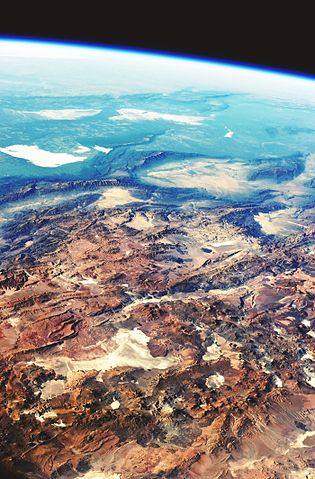
File:Central Andes Mountains, Salar de Arizaro, Argentina.jpg

Size of this preview: 315 × 479 pixels.
| |
This is a file from the Wikimedia Commons. Information from its description page there is shown below.
Commons is a freely licensed media file repository. You can help. |
Summary
| DescriptionCentral Andes Mountains, Salar de Arizaro, Argentina.jpg |
English: This image was taken by an astronaut looking south-east across the South American continent when the International Space Station (ISS) was almost directly over the Atacama Desert near Chile’s Pacific coast. The high plains (3000–5000 meters) of the Andes Mountains, also known as the Puna, appear in the foreground, with a line of young volcanoes facing the much lower Atacama Desert (1000–2000 m elevation). Several salt-crusted dry lakes (known as salars in Spanish) occupy the basins between major thrust faults in the Puna. Salar de Arizaro (foreground) is the largest of the dry lakes in this view. The Atlantic Ocean coastline, where Argentina’s capital city of Buenos Aires sits along the Río de la Plata, is dimly visible at image top left. Near image centre, the transition between two distinct geological zones, the Puna and the Sierras Pampeanas, creates a striking landscape contrast. Compared to the Puna, the Sierras Pampeanas mountains are lower in elevation and have fewer young volcanoes. Sharp-crested ridges are separated by wide, low valleys in this region. The Salinas Grandes—ephemeral shallow salt lakes—occupies one of these valleys. The general colour change from reds and browns in the foreground to blues and greens in the upper part of the image reflects the major climatic regions: the deserts of the Atacama and Puna versus the grassy plains of central Argentina, where rainfall is sufficient to promote lush prairie grass, known locally as the pampas. The Salinas Grandes mark an intermediate, semiarid region.
|
| Date | 17 May 2010 |
| Source | NASA Earth Observatory |
| Author | The NASA Expedition 23 crew |
|
Camera location |
25° 59′ 59.80″ S, 67° 30′ 0.10″ W |
View this and other nearby images on: Google Maps - Google Earth - OpenStreetMap | ( Info)-25.999944444444;-67.500027777778 |
|---|
| This image or video was catalogued by Johnson Space Centre of the United States National Aeronautics and Space Administration (NASA) under Photo ID: ISS023-E-28353. This tag does not indicate the copyright status of the attached work. A normal copyright tag is still required. See Commons:Licensing for more information. |
Taken with a Nikon D3S digital camera fitted with an 80 mm lens. Provided by the ISS Crew Earth Observations experiment and Image Science & Analysis Laboratory, Johnson Space Centre.
Licensing
| Public domainPublic domainfalsefalse |
 |
This file is in the public domain because it was solely created by NASA. NASA copyright policy states that "NASA material is not protected by copyright unless noted". (See Template:PD-USGov, NASA copyright policy page or JPL Image Use Policy.) |
 |
 |
Warnings:
|
| Annotations | This image is annotated: View the annotations at Commons |
1116
3091
128
121
2800
4256
Salar de Arizaro
512
988
149
64
2800
4256
Salinas Grandes
1123
988
135
64
2800
4256
Salinas Grandes
1009
490
405
277
2800
4256
Pampas
2139
1016
192
206
2800
4256
Sierras Pampeanas
831
2139
441
306
2800
4256
Puna (High Andes)
2402
3986
391
263
2800
4256
Atacama Desert
64
391
313
128
2800
4256
Rio de la Plata
File usage
The following pages on Schools Wikipedia link to this image (list may be incomplete):
Metadata
This file contains additional information, probably added from the digital camera or scanner used to create or digitize it. If the file has been modified from its original state, some details may not fully reflect the modified file.
| Camera manufacturer | NIKON CORPORATION |
|---|---|
| Camera model | NIKON D3S |
| Exposure time | 1/640 sec (0.0015625) |
| F-number | f/11 |
| ISO speed rating | 400 |
| Date and time of data generation | 12:32, 26 April 2010 |
| Lens focal length | 80 mm |
| Orientation | Normal |
| Horizontal resolution | 240 dpi |
| Vertical resolution | 240 dpi |
| Software used | GIMP 2.6.8 |
| File change date and time | 13:25, 17 May 2010 |
| Exposure Program | Aperture priority |
| Exif version | 2.21 |
| Date and time of digitizing | 12:32, 26 April 2010 |
| Shutter speed | 9.321928 |
| APEX aperture | 6.918863 |
| Exposure bias | 0 |
| Maximum land aperture | 3 APEX (f/2.83) |
| Metering mode | Pattern |
| Light source | Unknown |
| Flash | Flash did not fire |
| DateTime subseconds | 32 |
| DateTimeOriginal subseconds | 32 |
| DateTimeDigitized subseconds | 32 |
| Colour space | sRGB |
| Sensing method | One-chip colour area sensor |
| Custom image processing | Normal process |
| Exposure mode | Auto exposure |
| White balance | Auto white balance |
| Digital zoom ratio | 1 |
| Focal length in 35 mm film | 80 mm |
| Scene capture type | Standard |
| Contrast | Normal |
| Saturation | Normal |
| Sharpness | Normal |
| Subject distance range | Unknown |
A background to Schools Wikipedia
You can learn about nearly 6,000 different topics on Schools Wikipedia. SOS Children's Villages helps more than 2 million people across 133 countries around the world. Find out how you can help children in other countries.
